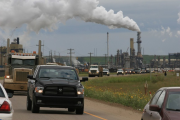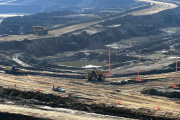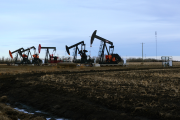We've all seen the photos: northern Alberta's boreal forest marked by open pit mines, polluting smokestacks and growing tailings lakes. It's what oilsands mining looks like. With this big mess comes a big price tag and it looks like Alberta taxpayers might be left on the hook for the lion's share ($10 to $15 billion) of the cleanup bill, according to a report recently released by the Pembina Institute.
We're told not to lose sleep over oilsands reclamation though. After all, oilsands mine operators are required to clean up the land they disturb. Just in case operators don't follow through with that reclamation, the Government of Alberta collects what amounts to a security deposit to cover reclamation costs.
The problem is, it doesn't look as though the Government of Alberta has been collecting enough money to cover the cleanup - not anywhere near enough money.
Neither oilsands operators nor government disclose what actual reclamation costs are or could be. But based on our assessment of limited government and industry data available, factoring in the costs of cleaning up mines and toxic tailings lakes, reclamation could cost in the range of $220,000 to $320,000 per hectare of land disturbed. That's a much higher number than what the Government of Alberta is holding oilsands mine operators to.
In 2009, the total oilsands reclamation security in the Environmental Protection Security Fund was only $820 million for the more than 68,574 hectares of disturbed land. That amounts to just $11,964 per hectare, which, by the Pembina Institute's conservative estimates, barely amounts to a drop in the bucket (less than five per cent of what could be required).
This $15-billion oversight potentially leaves Alberta taxpayers footing the bill. It flies in the face of a June 2010 Cambridge Strategies poll that showed 96 per cent of Albertans believe oilsands companies should held liable for all environmental damages caused by their operations.
There are numerous examples of companies bailing when it comes time to reclaim mines. In Canada, there are more than 10,000 abandoned or un-reclaimed mines. The cleanup bill paid by taxpayers is considerable.
One of the most well-known recent examples is the Sydney Tar Ponds, covering an area of 31 hectares on the eastern coast of Cape Breton Island, N.S. The decommissioned steel mill, previously operated by Sydney Steel Corporation, left behind more than a million tonnes of contaminated soil and sediment.
The toxic legacy was passed on to Canadian taxpayers with a cleanup bill of almost $500 million. Cleanup continues and the area will eventually be reclaimed with an impermeable barrier, clean soil and grass. Parts of the area may one day be used for recreational purposes. In Alberta, the area of land currently disturbed by oilsands mining is more than 2,200 times larger than the Sydney Tar Ponds.
Similarly, a bankrupt Faro Mine in the Yukon saddled taxpayers with the majority of a $450-million cleanup bill, since the government failed to collect an adequate security from the company. The examples only continue.
Clearly the process of collecting security from oilsands mines is broken, calling for much greater scrutiny and public debate. This comes as no surprise for Alberta's auditor general, who has raised concerns about the sufficiency of reclamation security policies four times in the last 11 years.
To its credit, the Government of Alberta has shown some interest in addressing the problem. The Mine Financial Security Program is set to replace the existing policy. The problem is, the program has been developed behind closed doors with industry.
No doubt the program may address some of the current shortcomings, but the process lacks transparency, accountability and proper stakeholder engagement. It is those key missing ingredients that got us into this mess in the first place.
There are many opportunities to improve accountability, display environmental leadership and demonstrate fiscal responsibility. Our latest report, Toxic Liability, outlines a wide-ranging suite of recommendations on mine liability management that can help the Government of Alberta to replace rhetoric with action.
Albertans don't want to be left holding the bag on cleaning up the oilsands - and it's time to make sure it will never happen.





